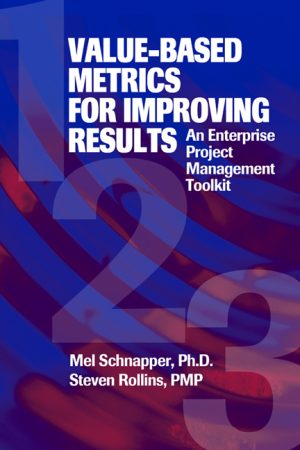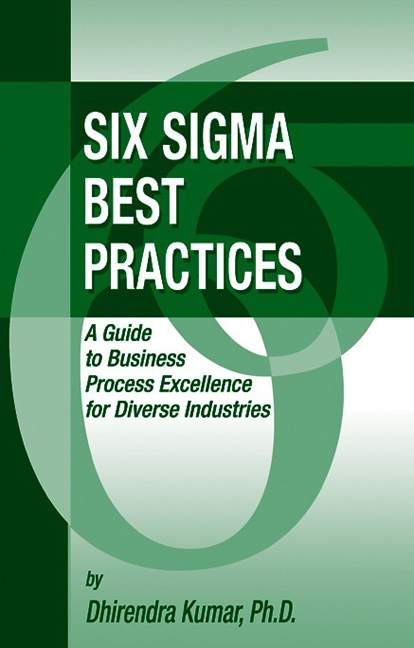Six Sigma Best Practices
$64.95
A Guide to Business Process Excellence for Diverse Industries
By Dhirendra Kumar
Hardcover, 6×9, 496 pages
ISBN: 978-1-932159-58-5
July 2006
Description
Continuous improvement has become synonymous with the Six Sigma process, where cost reduction and quality improvement have led to greater market share and profits. Leading organizations in diverse industries have begun to further deploy Six Sigma outside of manufacturing to maximize its benefits.
This comprehensive training tool and implementation guide delineates how Six Sigma methods can be applied to processes within numerous functional areas of the organization and in diverse industries to achieve strategic and operational business excellence. It presents step-by-step techniques and flow diagrams for integrating Six Sigma as best practices into business development and management. It provides a seamless integration of Six Sigma statistical methodologies that help businesses execute their strategic plans and track both their short- and long-term strategic progress within various areas of their business. Statistical methods employed in Six Sigma are thoroughly explained and their implementation, supported by examples and exercises, is demonstrated via Minitab 14, a popular statistical software package. Six Sigma Best Practices is an ideal text for executive training in planning and leading Six Sigma programs, for Yellow, Green and Black Belt certification programs, for college courses and as a desk reference for practitioners and consultants.
Key Features
- Illustrates how Six Sigma can be applied and implemented within numerous areas of an organization to achieve business process excellence that will lead to sustainable growth in profits and market share
- Presents Six Sigma concepts in common business terms as well as in applied statistics, where the benefits of the tool are better understood, and process centering, which is a prerequisite to Six Sigma implementation
- Details the measure phase of the DMAIC process extensively and develops the relationship between operational and financial metrics to show the biggest leverage points in an organization
- Demonstrates the implementation of statistical methods employed in Six Sigma via Minitab 14 software
- Covers project selection, planning, team development and management and shows how to develop and understand a project summary, which is critical to effective Six Sigma implementation
About the author(s)
Dhirendra Kumar has over thirty-five years of technical, management, teaching, and research experience with major U.S. corporations and universities. He has a Ph.D. in Industrial Engineering with a minor in Reliability Engineering and has been an adjunct professor at the University of New Haven since 1989. He started his career in the heavy equipment industry with John Deere, working on the reengineering and expansion program of Tractor Manufacturing Operation. In the mid-1980s, he reestablished his career in the aerospace industry with Pratt and Whitney, working on the total reengineering of the manufacturing facility from World War II to 21st century technology to introduce the production of new jet engines. He joined Pitney Bowes, Inc. in 1994 where he led the business optimization and development programs, providing modeling, hardware and software solutions, as well as coached and led continuous improvement (Kaizen, Lean and Six Sigma) programs.
Table of Contents
Chapter 1: Introduction
1.1 – History
1.2 – Business Market and Expectations
1.3 – What Is Sigma?
1.4 – Six Sigma Approach
1.5 – Road Map for Six Sigma Process
1.6 – Six Sigma Implementation Structure
1.7 – Project Selection
1.8 – Project Team Selection
1.9 – Project Planning and Management
1.10 – Project Charter
1.11 – Summary
Chapter 2: Define
2.1 – Customer
2.2 – High-Level Process
2.3 – Detailed Process Mapping
2.4 – Summary
Chapter 3: Measure
3.1 – Foundation of Measure
3.2 – Measuring Tools
3.3 – Data Collection Plan
3.4 – Data Presentation Plan
3.5 – Introduction to MINITAB
3.6 – Determining Sample Size
3.7 – Probabilistic Data Distribution
3.8 – Calculating Sigma
3.9 – Process Capability (Cp, Cpk) and Process Performance (Pp, Ppk) Indices
3.10 – Summary
Chapter 4: Analyze
4.1 – Stratification
4.2 – Hypothesis Testing: Classical Techniques
4.3 – Hypothesis Testing: The Chi-Square Technique
4.4 – Analysis of Variance
4.5 – Regression and Correlation
4.6 – Summary
Chapter 5: Improve
5.1 – Process Reengineering
5.2 – Guide to Improvement Strategies for Factors and Alternatives
5.3 – Introduction to Design of Experiments
5.4 – Solution Alternatives
5.5 – Summary
Chapter 6: Control
6.1 – Self-Control
6.2 – Monitor Constraints
6.3 – Error-Proofing
6.4 – Statistical Process Control Techniques
6.5 – Final Project Summary
6.6 – Summary
Appendices:
Business Strategic Planning
The Manufacturing Strategy and the Supply Chain
The Production Systems and Support Services
Glossary of Terms
Tables
Index
Reviews
“Unlike other texts on the subject, Dr. Kumar’s book covers six sigma from the perspective of a practitioner working in the trenches of a large manufacturer, coping with the realities of training large numbers of people and showing how quality results improve the bottom line and product reputation. This is important: too many authors take a glossy, generalized approach to six sigma, emphasizing its benefits without giving a detailed map showing how to get there, create a totally supportive culture, and stay there for the long term in a competitive global environment. Dr. Kumar has all the statistics, but carefully leads the reader through them in plain English and with plenty of detailed examples. It is easy to follow, realistic, and delivers a true sense of what one meets in practice on the shop floor.”
— Alex Sommers, Ph.D., Professor of Industrial Engineering, University of New Haven
Related products
-

Aircraft Finance
Retail Price: $99.95$89.95 Add to cart -

Essential Project Investment Governance and Reporting
Retail Price: $59.95$49.95 Add to cart -

Six Sigma for Small and Mid-Sized Organizations
Retail Price: $49.95$44.95 Add to cart -

Value-Based Metrics for Improving Results
Retail Price: $54.95$49.95 Add to cart -

Financially Focused Project Management
Retail Price: $54.95$44.95 Add to cart

